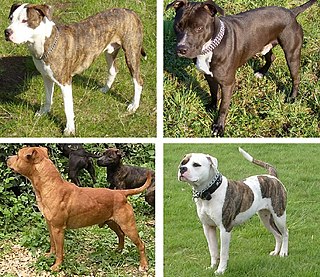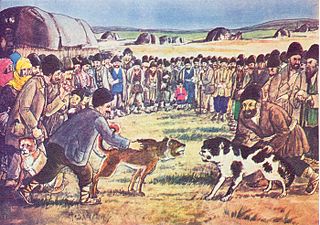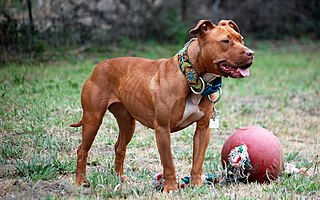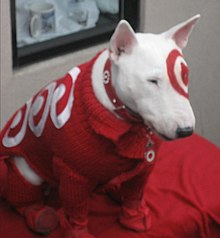
Pit bull is an umbrella term for several types of dog believed to have descended from bull and terriers. In the United States, the term is usually considered to include the American Pit Bull Terrier, American Staffordshire Terrier, American Bully, Staffordshire Bull Terrier, and sometimes the American Bulldog, along with any crossbred dog that shares certain physical characteristics with these breeds. In other countries, including the United Kingdom, the term is used as an abbreviation of the American Pit Bull Terrier breed specifically, while the Staffordshire Bull Terrier is not considered a pit bull. Most pit bull-type dogs descend from the British bull and terrier, a 19th-century dog-fighting type developed from crosses between the Old English Bulldog and the Old English Terrier.

Nipper, also known as the RCA Victor dog, was a dog from Bristol, England. Bred as a terrier mix, he served as the model for a 1898 painting by British painter Francis Barraud titled His Master's Voice. This image became one of the world's best known trademarks, the famous dog-and-gramophone pairing that was used by several record companies and their associated company brands, including Berliner Gramophone and its various affiliates and successors, among them Berliner's German subsidiary Deutsche Grammophon; Berliner's American successor the Victor Talking Machine Co. ; Zonophone; Berliner's British affiliate the Gramophone Co. Ltd. and its successors EMI and HMV Retail Ltd.; the Gramophone Co.'s German subsidiary Electrola; and onetime Victor subsidiary the Japan Victor Company (JVC).

The Jack Russell Terrier is a British breed of small terrier. It is principally white-bodied and smooth-, rough- or broken-coated, and can be any colour.

The Staffordshire Bull Terrier, also called the Staffy or Stafford, is a purebred dog of small to medium size in the terrier group that originated in the northern parts of Birmingham and in the Black Country of Staffordshire, for which it is named. They descended from 19th-century bull terriers that were developed by crossing bulldogs with various terriers to create a generic type of dog generally known as bull and terriers. Staffords share the same ancestry with the modern Bull Terrier, although the two breeds developed along independent lines, and do not resemble each other. Modern Staffords more closely resemble the old type of bull terrier, and were first recognised as a purebred dog breed by The Kennel Club of Great Britain in 1935.

Dog fighting is a type of blood sport that turns game and fighting dogs against each other in a physical fight, often to the death, for the purposes of gambling or entertainment to the spectators. In rural areas, fights are often staged in barns or outdoor pits; in urban areas, fights are often staged in garages, basements, warehouses, alleyways, abandoned buildings, neighborhood playgrounds, or in the streets. Dog fights usually last until one dog is declared a winner, which occurs when one dog fails to scratch, dies, or jumps out of the pit. Sometimes dog fights end without declaring a winner; for instance, the dog's owner may call the fight.

The Boston Terrier is a breed of dog originating in the United States of America. This "American Gentleman" was accepted in 1893 by the American Kennel Club as a non-sporting breed. Boston Terriers are small and compact with a short tail and erect ears.

In law, breed-specific legislation (BSL) is a type of law that prohibits or restricts particular breeds or types of dog. Such laws range from outright bans on the possession of these dogs, to restrictions and conditions on ownership, and often establishes a legal presumption that such dogs are dangerous or vicious to prevent dog attacks. Some jurisdictions have enacted breed-specific legislation in response to a number of fatalities or maulings involving pit bull–type dogs or other dog breeds commonly used in dog fighting, and some government organizations such as the United States Army and Marine Corps have taken administrative action as well. Due to opposition to such laws in the United States, anti-BSL laws have been passed in 21 of the 50 state-level governments, prohibiting or restricting the ability of jurisdictions within those states to enact or enforce breed-specific legislation.

The Smooth Fox Terrier is a breed of dog, one of many terrier breeds. It was the first breed in the fox terrier family to be given official recognition by The Kennel Club. It is well known, and although not a widely popular breed today outside hunting and show circles, it is extremely significant due to the large number of terriers believed descended from the breed.

Spuds MacKenzie is a fictional dog character used for an extensive advertising campaign marketing Bud Light beer in the late 1980s. The Spuds MacKenzie mascot and campaign was the idea of a 23-year-old art director, Jon Moore. At the time, he was working at Needham, Harper, and Steers, a Chicago advertising agency. The dog first showed up in a Bud Light Super Bowl XXI ad in 1987.

The American Pit Bull Terrier (APBT) is a dog breed recognized by the United Kennel Club (UKC) and the American Dog Breeders Association (ADBA), but not the American Kennel Club (AKC). It is a medium-sized, short-haired dog, of a solid build, whose early ancestors came from England. When compared with the English Staffordshire Bull Terrier, the American Pit Bull Terrier is larger by margins of 6–8 inches (15–20 cm) in height and 25–35 pounds (11–16 kg) in weight. The American Pit Bull Terrier varies in size: males are normally about 18–21 inches (45–53 cm) in height and around 35–60 pounds (15–27 kg) in weight, while females are normally around 17–20 inches (43–50 cm) in height and 30–50 pounds (13–22 kg) in weight.

The American Staffordshire Terrier, also known as the AmStaff, is a medium-sized, short-coated American dog breed recognized by the American Kennel Club, but not the United Kennel Club, which instead allows American Staffordshire Terriers to be registered under the American Pit Bull Terrier breed.
Bullseye or Bull's Eye may refer to:

The Bull Terrier is a breed of dog in the terrier family. There is also a miniature version of this breed which is officially known as the Miniature Bull Terrier. This breed originates in 19th century England. Originally bred for vermin control and bloodsports, this breed can be independent and stubborn.

Bull and terrier was a common name for crossbreeds between bulldogs and terriers in the early 1800s. Other names included half-and-halfs and half-breds. It was a time in history when, for thousands of years, dogs were classified by use or function, unlike the modern pets of today that were bred to be conformation show dogs and family pets. Bull and terrier crosses were originally bred to function as fighting dogs for bull- and bear-baiting, and other popular blood sports during the Victorian era. The sport of bull baiting required a dog with attributes such as tenacity and courage, a wide frame with heavy bone, and a muscular, protruding jaw. By crossing bulldogs with various terriers from Ireland and Great Britain, breeders introduced "gameness and agility" into the hybrid mix.

Sergeant Stubby was a dog and the unofficial mascot of the 102nd Infantry Regiment and was assigned to the 26th (Yankee) Division in World War I. He served for 18 months and participated in 17 battles and four offensives on the Western Front. He saved his regiment from surprise mustard gas attacks, found and comforted the wounded, and allegedly once caught a German soldier by the seat of his pants, holding him there until American soldiers found him. His actions were well-documented in contemporary American newspapers.

Smoky, a Yorkshire Terrier, was a famous war dog who served with the Allied Forces in World War II. She weighed only 4 pounds (1.8 kg) and stood 7 inches (180 mm) tall. Smoky is credited with beginning a renewal of interest in the once-obscure Yorkshire Terrier breed.

The American Bully is a modern breed of dog that was developed as a companion dog, and originally standardized and recognized as a breed in 2004 by the American Bully Kennel Club (ABKC). Their published breed standard describes the dog as giving the "impression of great strength for its size". In 2008, the American Bully was recognized by the European Bully Kennel Club (EBKC), and on July 15, 2013, by the United Kennel Club (UKC). The UK Kennel Club, American Kennel Club, and International Canine Federation do not recognize the American Bully as a separate breed.
















